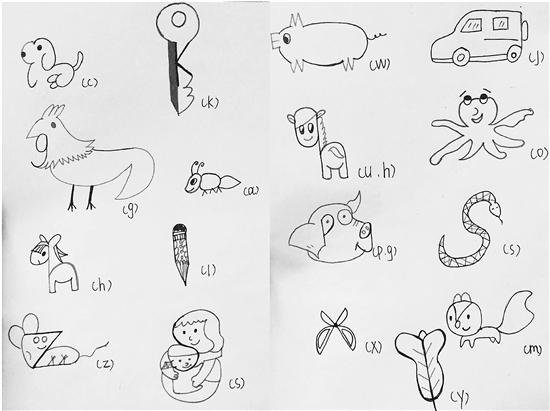
The summer vacation is about to return to zero. These days, not only students who have not finished their homework, but also novice teachers who are about to take over the first batch of students in their lives are in a state of intense preparation. For the new semester that will start soon, their hearts are both looking forward to and uneasy.
Jiang Li, a teacher at Dinglan No.2 Primary School in Hangzhou, went to Qianbao reporter to tell her recent distress. Because Mr. Ding found that the "opening gift" that he started preparing for freshmen early may not be used.
It is a difficult problem for freshmen to learn pinyin.
She racked her brains to think of a way.
Teacher Jiang is a post-1995, who just joined this year. After the new semester begins, she will be the Chinese teacher and head teacher of Class 1 (5) in the school.
Because he is a novice, this summer vacation, Mr. Jiang has almost no rest and has been preparing for the new semester. Nowadays, all primary schools advocate zero-based admission, regardless of pinyin or literacy, they begin to learn after entering primary school. Therefore, when preparing lessons, Mr. Jiang thought a lot of countermeasures for the problems that zero-based students often encounter when they are beginners.
"For children in grade one, pinyin is very difficult to learn. Because letters are too abstract for them, it is difficult to establish a connection between letters and pronunciations, and many letters with similar shapes and sounds are easily confused. " Teacher Jiang said.
This summer vacation, she has been thinking about pinyin. How can we help children learn pinyin effectively?
Not long ago, when practicing the standard writing of pinyin, Teacher Jiang had an epiphany and came up with a way — — Hand-drawn cartoon pinyin table.
"In math textbooks, in order to let children remember the writing of numbers, each number will be integrated into cartoon pictures. Pinyin and numbers are abstract symbols. If pinyin letters are also integrated into cartoon patterns, they may have the same effect. " Teacher Jiang explained.
After having an idea, she immediately started to work and spent an hour to finish the preliminary drawing of the cartoon pinyin table. On this pinyin table, some common animals or articles are painted, and one or two pinyin letters are "inlaid" in each pattern. "Now this is just a sketch. I’m going to ask the art teacher for help to further beautify and simplify the pattern, and then use it as a teaching tool for students to consolidate their knowledge and expand their thinking." Teacher Jiang said that she also considered letting students draw together, and the "mosaic" way of patterns and letters was designed by the students themselves.
I have to say that this is a very creative idea. Adding vivid teaching methods such as pictures, jingles and finger dancing to the classroom can help junior children enjoy the class more quickly and develop their imagination.
However, Mr. Jiang soon found that his "opening ceremony" carefully prepared for the students was probably not used.
More than half the students in the class.
I finished learning pinyin in advance.
"I know that some students will definitely learn Pinyin in advance during the summer vacation, but the proportion should not be too large, and even if they want to learn, they will not learn it systematically." Teacher Jiang said.
These two days, she made a home visit to the students in her class, and this idea was completely subverted. "I found that more than half of the students in the class have almost finished learning Pinyin in advance." During her home visit, she specially brought her textbooks to check on the spot. Many students who have studied pinyin have mastered the most difficult polysyllabic pinyin and can basically spell it freely.
"I can understand the anxiety of parents who are afraid that their children can’t keep up with the start of school, but every teacher will prepare lessons according to the progress of the class before class. Such advanced learning will disrupt the teacher’s teaching plan." Teacher Jiang said helplessly. In her opinion, such advanced learning is not necessarily good for children.
"In class, I will abide by the barrel principle and take students who have not mastered pinyin as the standard. I will not give up those who have not learned because most people have learned it." Teacher Jiang said. Moreover, during her home visit, she found that many students’ pronunciation was not standard when they were receiving off-campus training because the teacher didn’t teach them seriously. After all, Pinyin is the most basic thing in Chinese learning. If there are mistakes at the beginning, it will be more difficult to correct them later, which will also have a negative impact on children’s future study.
After discovering this problem, Mr. Jiang was busy again, and the lesson plans that had been prepared for more than half a month needed to be readjusted.
"In the past, preparing lessons was based on zero-based children. Now we need to redesign the way of class according to the differences in students’ learning level." Teacher Jiang said. In the future teaching, she will pay more attention to students with zero starting point and cultivate their interest in learning as soon as possible. For those children who have learned pinyin, she will pay attention to their learning methods and spelling methods, and get rid of some incorrect places, so that they can apply pinyin to Chinese learning as soon as possible.
"You can also let the children who have learned Pinyin study with other children to form a good learning atmosphere." Teacher Jiang said. (Reporter Jianwei Liang correspondent Chen Hongcheng)
关于作者